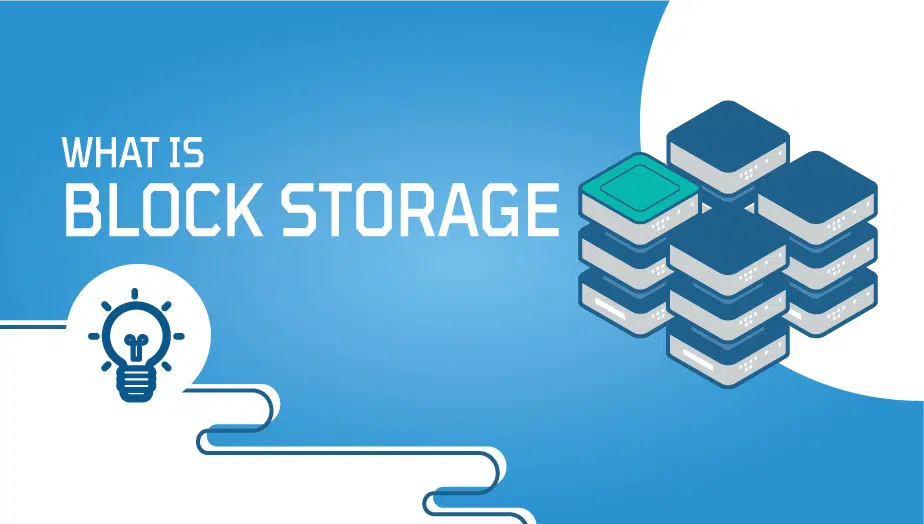What is Block storage?
Data block storage can be used as a single hard drive on a server or computer. Like local storage, it operates similarly. Despite the similarities, there is one noticeable difference. In contrast to local storage, which keeps all data on your server, block storage takes that data and stores it in a centralized storage cluster that is both high-speed and redundant.
In the case of block storage, all communication takes place over the network. Assigning a server of almost any size volume can be accessed over a fiber channel over ethernet or Internet small computer systems interface is possible.
SANs are commonly used as high-performance file storage alternatives in storage area networks (SANs). Block storage is available through a variety of cloud-based services. Among the most notable examples are Azure Managed Disk, Google Cloud Persistent Disk, and AWS Elastic Block Storage.
Who Provides Block Storage?
VPSie is a provider of block storage. They offer block storage as an add-on to their virtual private servers (VPS), which allows customers to scale their storage capacity as their needs multiply. The block storage provided by VPSie uses enterprise-grade hardware and is configured for high performance and reliability.
Customers can easily manage their block storage through the VPSie.com control panel, which provides a user-friendly interface for creating and managing storage volumes.
VPSie is a provider of block storage that can be used with their virtual private servers (VPS). However, many other block storage providers can be used independently or with a VPS.
Some popular block storage providers include Amazon Web Services (AWS), Google Cloud Platform, Microsoft Azure, DigitalOcean, Linode, and Vultr. Each provider has unique features, pricing, and performance characteristics, so evaluating different options is essential to your specific needs and requirements.
How does it work?
Block storage works by dividing data into fixed-size blocks, which are then stored on a storage device similar to a hard disk drive (HDD) or solid-state drive (SSD). Each block is assigned a unique identifier, which is used to locate and retrieve the block when needed.
Data is first divided into fixed-size blocks when written to the storage device. The storage system then assigns each block a unique identifier and stores it on the device. When data needs to be read from the storage device, the application sends a request to the storage system for the specific block it needs. The storage system uses the unique identifier to locate and retrieve the block from the device and sends it back to the application.
Block storage can be configured differently to meet the organization’s specific needs. For example, multiple disks can be combined to create a logical volume, which appears to the operating system as a single disk. This allows for greater flexibility in managing storage resources and can improve performance by allowing multiple disks to be used in parallel.
Block storage also uses redundancy to protect against hardware failures. Redundant arrays of independent disks (RAID) are commonly used to store multiple copies of data across multiple disks. If one disk fails, the data can be retrieved from the redundant copy stored on another.
Overall, block storage is a powerful and flexible method allowing high-speed data access and scalability. Its ability to store data as fixed-size blocks and use redundancy to protect against hardware failures makes it an ideal choice for enterprise IT environments that require high-performance and resilient storage solutions.
Features of Block Storage
- High Performance: Block storage is known for its high performance and low latency. It allows applications to read and write data directly to the storage device, reducing latency and improving performance.
- Scalability: Block storage is highly scalable and can accommodate large amounts of data. As the demand for storage increases, more disks can be added to the system to meet the organization’s growing needs.
- Flexibility: Block storage is highly flexible and can be configured to meet the organization’s specific needs. It can be configured to support different operating systems, file systems, and protocols.
- Resilience: Block storage is resilient and can withstand hardware failures. It uses redundant arrays of independent disks (RAID) to protect data against disk failures.
Advantages of Block Storage
- High Performance: Block storage offers high-speed data access, making it an ideal choice for databases, virtual machines, and other data-intensive applications.
- Scalability: Block storage is highly scalable and can accommodate large amounts of data. As the demand for storage increases, more disks can be added to the system to meet the organization’s growing needs.
- Flexibility: Block storage is highly flexible and can be configured to meet the organization’s specific needs. It can be configured to support different operating systems, file systems, and protocols.
- Resilience: Block storage is resilient and can withstand hardware failures. It uses redundant arrays of independent disks (RAID) to protect data against disk failures.
- Security: Block storage offers high levels of security, with access controls and encryption features to protect data from unauthorized access.
Disadvantages of Block Storage
- Complexity: Block storage can be complex to manage and requires specialized skills to configure and maintain. Organizations may need to invest in additional resources or hire outside expertise to manage the storage system effectively.
- Cost: Block storage can be expensive, especially compared to other storage types, such as object storage. Organizations may need to weigh the cost against the performance benefits to determine if block storage is the right choice for their needs.
- Limited Accessibility: Block storage is typically only accessible by one server or application at a time, limiting its accessibility for use cases such as file sharing.
Block Storage vs. Object Storage
Block storage is often compared to object storage, another type used in enterprise IT environments. Object storage stores data as objects consisting of data, metadata, and a unique identifier. These objects are stored in a flat location space and are accessible through a unique identifier. Object storage is used for large-scale unstructured data applications like images and videos.
The main variation between block and object storage is how data is accessed. Block storage allows applications to read and write data directly to the storage device, while object storage uses a RESTful API to access data stored in objects. This makes object storage more suitable for applications that require large-scale storage of unstructured data, while block storage is ideal for applications that require high-speed data access.
Conclusion For Block Storage
Block storage is a powerful and flexible method offering high performance and scalability for enterprise IT environments. Its ability to support databases, virtual machines, and other data-intensive applications makes it an ideal choice for organizations looking to improve their data storage capabilities. However, the complexity and cost of block storage can be a barrier for some organizations, and they may need to consider other storage options, such as object storage.
Organizations must consider their needs and requirements when deciding whether to use block or object storage. Block storage offers high-speed data access and is ideal for software that requires low latency and high performance. On the other hand, object storage is better suited for applications requiring large-scale unstructured data storage.
In conclusion, block storage is a valuable tool for enterprise IT environments that require high-speed data access and scalability. Its flexibility and resilience make it ideal for data-intensive applications such as databases and virtual machines. However, organizations need to weigh the cost and complexity of block storage against their specific needs and requirements to determine if it is the right choice for them.
Block storage stores data on a storage device such as a hard disk or solid-state drive. Data is divided into fixed-size blocks, each assigned a unique identifier and stored on the device. Block storage is ideal for high-speed data access and low-latency applications.
Block storage differs from other storage methods, such as file and object storage. File storage is used for storing files and documents, while object storage is used for storing large amounts of unstructured data. Block storage is used for storing data in fixed-size blocks, allowing high-speed data access and flexibility in managing storage resources.
Block storage offers several advantages, including high-speed data access, low latency, and flexibility in managing storage resources. It is also resilient and can protect against hardware failures by using redundancy to store multiple copies of data across multiple disks.
Block storage can be complex and expensive, especially for smaller organizations. It also requires specialized skills and knowledge to manage effectively. Additionally, block storage could be better for storing large amounts of unstructured data, which is better suited for object storage.
Block storage is ideal for applications that require high-speed data access and low latency, such as databases and virtual machines. It is also suitable for applications requiring high resilience and redundancy levels to protect against hardware failures.





















